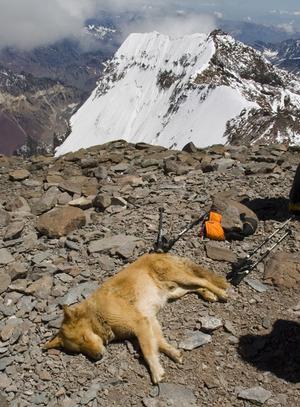Whether it is for the joy of climbing the mountain itself, or for the statistic alone, Argentina’s Cerro Aconcagua has occupied a position of prominence on many a climber’s wish-list. Known to many as “The Stone Sentinel”, this colossal mound of ice and scree soars to 6,962 meters above sea-level. It sounds even better when measured in feet: there are 22,841 of them, which makes Aconcagua the highest point in all of South America. It’s big; so big, that if the Himalayas were to somehow crumble down into nothing, the new “highest point on earth” would be, you guessed it, Cerro Aconcagua.
Statistics aside, climbing Aconcagua is simply a great adventure. Lenticulars, penitentes, the infamous “viento blanco”… there’s a lot to keep a climber engaged. The journey is easy enough to keep you encouraged, yet challenging enough to be a major notch in your belt.
For whatever reason one finds themselves attracted to Aconcagua, something that isn’t attractive is the high cost of climbing it with one of the various commercial operators that lay siege to the mount each year. A quick browse of the Internet will reveal tour costs of thousands of dollars. If you’re made of money, those prices are probably good value. Your purchase will most likely ensure a comfortable base-camp, uncomplaining mules to haul your kit, and good food on demand. Your funds will also buy you one or more bilingual guides, who will all but carry you to Aconcagua’s apex for those glorious few minutes of victory.
Yes, if you can afford it, climbing Aconcagua with a commercial guide will give you a fine chance of success. But if you’re a reasonably competent climber & traveler, have a buddy or two who are also up to the challenge, and you’d rather save some dough for future conquests, then going it alone is an excellent option. Here are my tips, based on a successful ascent made in January 2007, which will help you save money, and get to the top also!
Firstly, get a copy of R.J Secor’s “Aconcagua: A Climbing Guide”. The maps and route descriptions are very helpful. However, taking along a good topographical map is critical, and Secor’s guide doesn’t have one. Topographical maps can be found on the streets of Mendoza in the various map stores & climbing outfitters you’ll come across.
Try to spend some time at altitude before you begin your expedition, and train well! If you’ve already been acclimatizing somewhere else, you won’t need to spend weeks in base-camp squandering your precious supplies while your body gets used to the altitude.
Travel to Mendoza, Argentina cheaply. If you’ve got the time, take the bus from your point of entry in Argentina. For example, if you arrive in Buenos Aires, you’ll probably save a lot of money if you take the bus to Mendoza, rather than fly. Bus services are excellent, and you’ll even get to brush up on your Spanish with some dubbed movies.
If you can help it, don’t buy climbing equipment in Mendoza. The prices are inflated, and there isn’t a huge selection for you to choose from anyway.
Make it your determination to view the purchase of your climbing permit (at the Direccion de Bosques y Parques Provinciales in downtown Mendoza) as your major expense from here on out!
Inquire with the local guides in Mendoza for transport to and/or from the mountain. Sometimes, they’ll let you travel with their organized group to the park entrance, for a small fee. It may save you some time and bother. Otherwise, there are regular buses that run between the main bus terminal in Mendoza, and Puente del Inca.
In my opinion, this final point is perhaps the most important: Take care when selecting the food for your expedition. Food can make or break and expedition. Choose nutritious, lightweight, tasty food. Choosing food you enjoy does a lot for your psychology. Part of what makes mountaineering potentially so miserable, is forcing yourself to eat unpalatable food where the high altitude has already taken away your appetite. If you enjoy eating it, you’ll be happier, and you’ll probably eat more – giving you good reserves of the energy you’ll be burning so fast during the day. Consider pre-cooking some favorite meals yourself and then dehydrating them. They’ll pack small, and you’ll only have to rehydrate and heat them while on the mountain – saving you in two ways: a) You’ll use less fuel for your stove since you won’t need to cook anything, just heat it; and b) You probably won’t have to hire expensive mules or mule-drivers, since you’ll now be able to carry less fuel, and your food will be small and light enough for you to carry on your back.
With some good planning, you should be able to stage a successful campaign on Aconcagua for only a few hundred dollars, the majority of your land expense being the climbing permit.
It’s true, there really is something very special about being on top; stabbing at that rarefied air with your ice-ax; the “slain beast” subjected to your crampon-clad boot. It’s a sweet feeling no matter how you got there. But without a doubt, overcoming that ‘mountain of challenge’ through an expedition supplied by your own rucksack brings a whole new level of satisfaction. The adventure was directed by you, and the only profits made were your own fond memories.
Hopefully you’ll still have enough ‘dinero’ for your next adventure, but certainly you’ll have enough for that fat steak and glass of red you promised yourself in Mendoza.
Salud!


